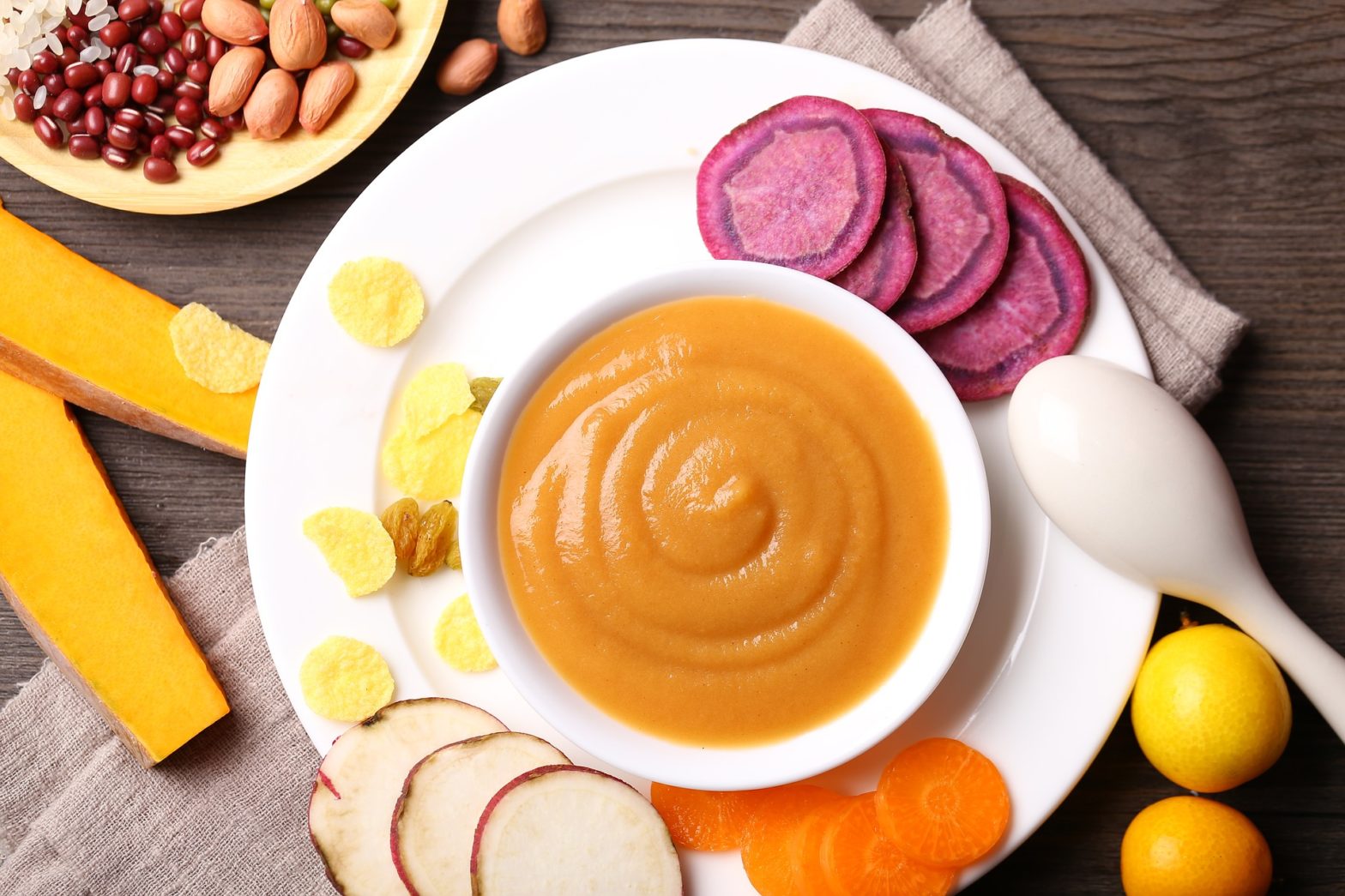Intro
In this article we’ll give an overview why the sweet potato is a staple of baby food and how to incorporate it in the little guys daily diet. We will go into how to choose the right type of sweet potato for different kinds of dishes (puree, wedges etc), how to store it and what to do if we don’t have time for cooking at all.
If you are eager for recipes then jump here.
What’s a Sweet Potato?
First off let’s get to know our little versatile cooking friend – the sweet potato. Sweet potato origins are from Southern America. Nowadays, sweet potatoes are cultivated in America, Asia and New Zealand. The USA produces more high quality sweet potatoes but China is the world’s largest producer. It is very hard to grow sweet potatoes in Europe. The sweet potato is a tropical vegetable which means it needs enough water and a long warm season of 110 days with temperatures of at least 30 degrees Celsius. The nights must also be quite warm (above 20 degrees Celsius).
Sweet potatoes are considered root vegetables, At first sight sweet potato and regular potato seem to be very similar, but shape, colour and taste are very different. Sweet potatoes taste more like carrots and are way easier to cook. Never store sweet potatoes in the refrigerator before cooking, instead choose a dark and cool place. After cooking sweet potatoes it’s great to refrigerate or freeze them.
Sweet potatoes are often mistaken for yams. Both plants are angiosperms (flowering plants) but they are not biologically related. Yams can grow way bigger than a sweet potato, about 130 pounds. Yams are not as sweet at all. Their flesh is drier, starchier and it’s skin is darker. Nutrition is also quite different as they are actually quite low in Vitamin A compared to sweet potatoes.
Nutrition and Health Benefits
Sweet potatoes are very high in the antioxidant beta carotene (converted into Vitamin A) and rich in vitamin C and potassium.
Sweet potatoes are also high in starch and simple sugars which puts it on the medium to high GI index. The GI index shows how fast your blood sugar level rises after a meal. They are also high in fiber which keeps you full and reduces blood sugar spikes by slowing your digestion of sugars and starches. Boiling sweet potatoes decreases the GI index and increases the absorption of Vitamin C.
These lovely potatoes are also high in Vitamin B6, B5, Vitamin E and Manganese.
The brighter the potato color (purple, deep orange and red) the higher they are in antioxidants. Purple sweet potatoes contain high levels of anthocyanin which possesses high antioxidant properties.
Sweet potatoes are considered a better choice than regular potatoes because of the higher vitamin and fiber content.
Make sure you weigh your sweet potato in a raw state if you use the following table for stats 😉
Nutrition Facts
Sweet Potato, Raw
Source: NCCDB, Amount per 100g
| Calories | 86 kcal | 4% |
| Total Fat | 0.1 g | 0% |
| Saturated Fat | 0 g | |
| Trans Fat | 0 g | |
| Cholesterol | 0 mg | |
| Sodium | 55 mg | 2% |
| Total Carbohydrate | 20.1 g | 7% |
| Dietary Fiber | 3 g | 12% |
| Sugars | 4.2 g | |
| Protein | 1.6 g | 3% |
Vitamins and Minerals:
| Vitamin A | 14187 IU | 284% |
| Vitamin C | 2.40 mg | 4% |
| Calcium | 30 mg | 3% |
| Iron | 0.61 mg | 3.4% |
| Vitamin B6 | 0.21 mg | 10.5% |
| Folate | 11 μg | 2.8% |
| Vitamin E | 0.26 mg | 1.3% |
| Vitamin K | 1.8 μg | 2.3% |
| Magnesium | 25 mg | 6.3% |
| Potassium | 337 mg | 9.6% |
| Manganese | 0.26 mg | 12.9% |
How to Choose the Right Type
The result of cultivating sweet potatoes for hundreds of years has given mankind a wide variety of types to choose from.
As mentioned before don’t confuse sweet potatoes for yams! In the west most likely when you encounter something with the label “yam” then it’s actually a sweet potato. Yams are mostly grown in Africa and Asia.
How to choose the right type of sweet potato? In general for purees use the more moist type and for fries/wedges/salads use the more denser types.
There is an array of sweet potatoes with fancy European farmer names like Beauregard and Covington, but most likely in the stores you will encounter one of the following popular types:
The “Popular” Sweet Potatoes: Beauregard and Jewel
Also known as “Orange” Sweet Potato.
When picking up a sweet potato from the supermarkets then it’s most likely Beauregard or Jewel. This is due to these types being very versatile and giving good yield to farmers. And they also have a great taste and have won many awards!
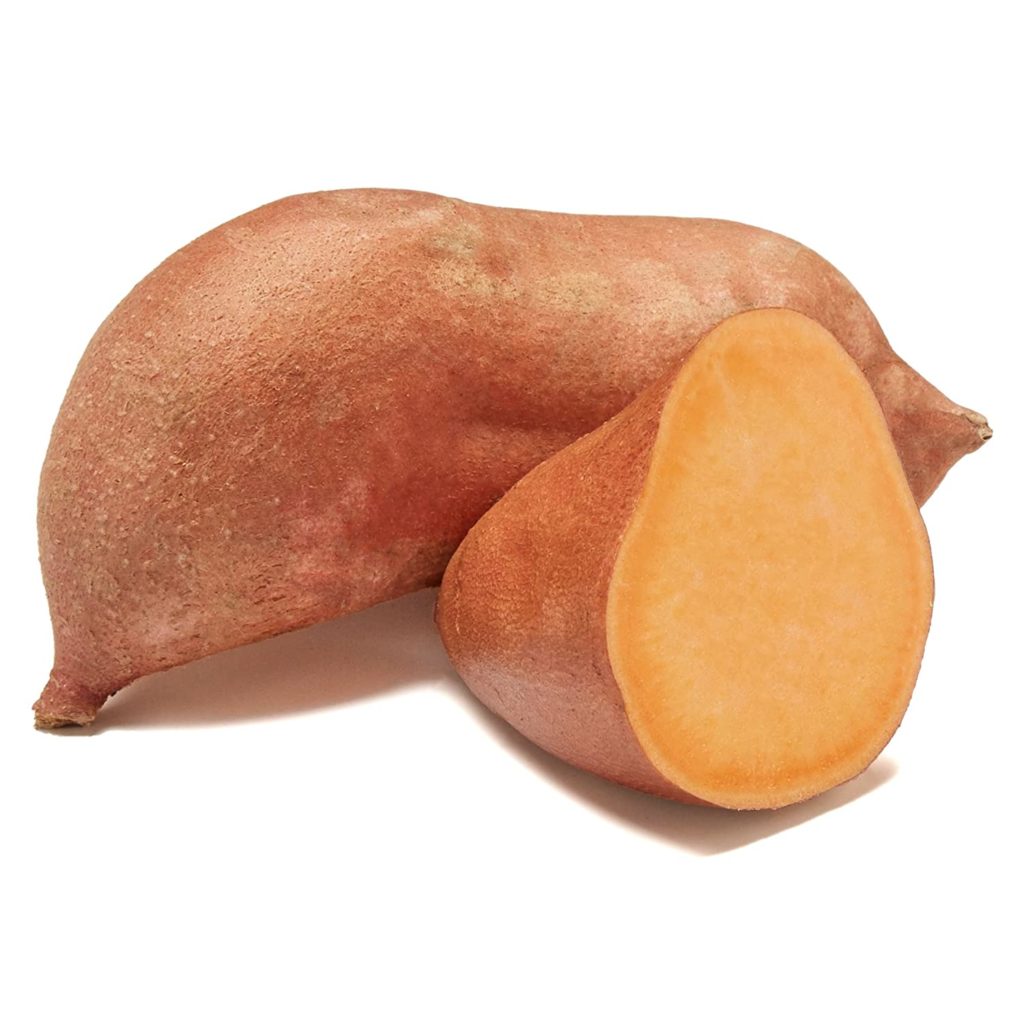
These types might not have the same chewy bite as others and are maybe not as complex on the taste. But they are good all-arounders.
The main difference between Beauregard and Jewel is that Jewel is less sweet and has lighter skin.
The orange sweet potato is more moist and thus is the best for making purees for babies.
Japanese Sweet Potato
Also known as “Satsuma-imo Sweet Potato”.
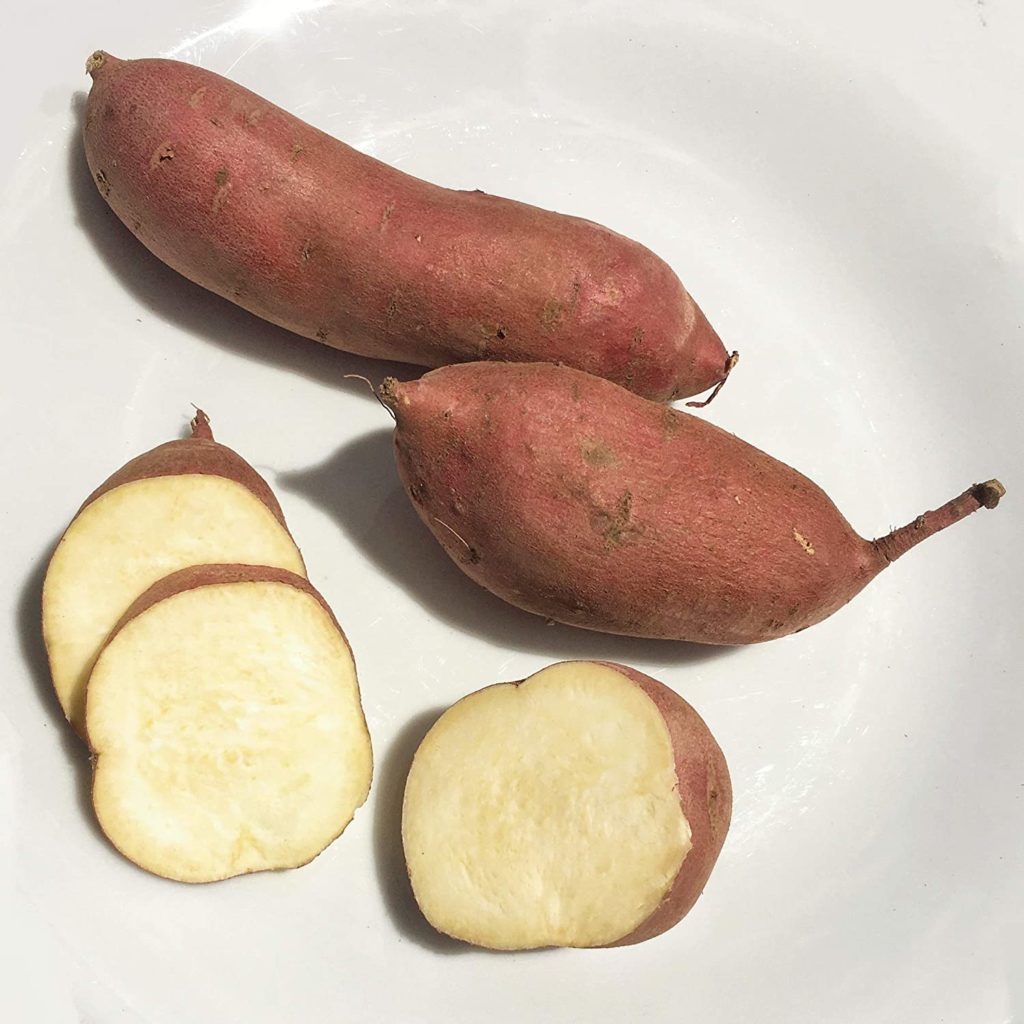
Don’t confuse this guy with other japanese-like named sweet potatoes (Okinawan, Kotobuki). Although this type is indeed very popular in Okinawa 🙂
This sweet potato has yellow flesh and red or purple skin. They are a bit more dense and less moist than the “Popular” type. The taste is sweet but subtle and there is also a slight nutty taste.
This type is also good for fries and wedges.
Okinawan Sweet Potato
Also known as “Hawaiian Sweet Potato”, “Japanese Purple Sweet Potato”, “Uala Sweet Potato”
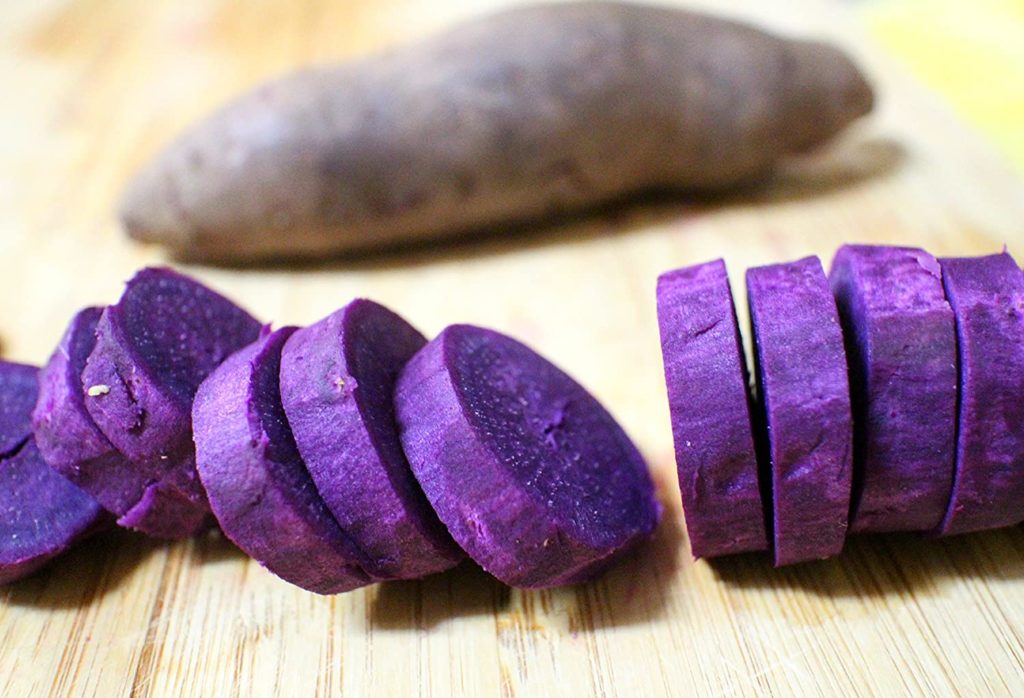
Most distinguishing about this specimen is the vivid purple flesh. It has a creamy texture and slightly sweet taste. As you can tell from the name it is very popular in Okinawa and Hawaii. They are also more denser than the “Popular” type. Use this one to bright up your salads with a bright purple color. Also good for wedges.
Stokes Purple Sweet Potato
Also known simply as “Purple Sweet Potato”
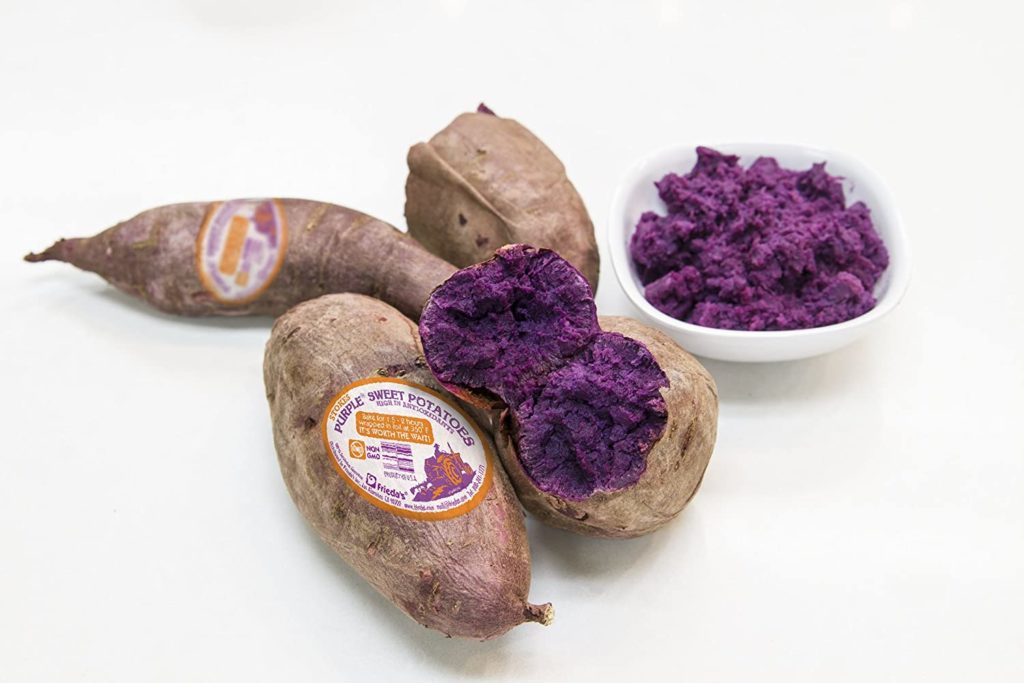
Not to be confused with Okinawan, this sweet potato originates from North Carolina. These purple fleshed sweet potatoes have a drier and denser texture than most “Popular” types.
Hannah White Sweet Potato
Also known as “White Sweet Potato”
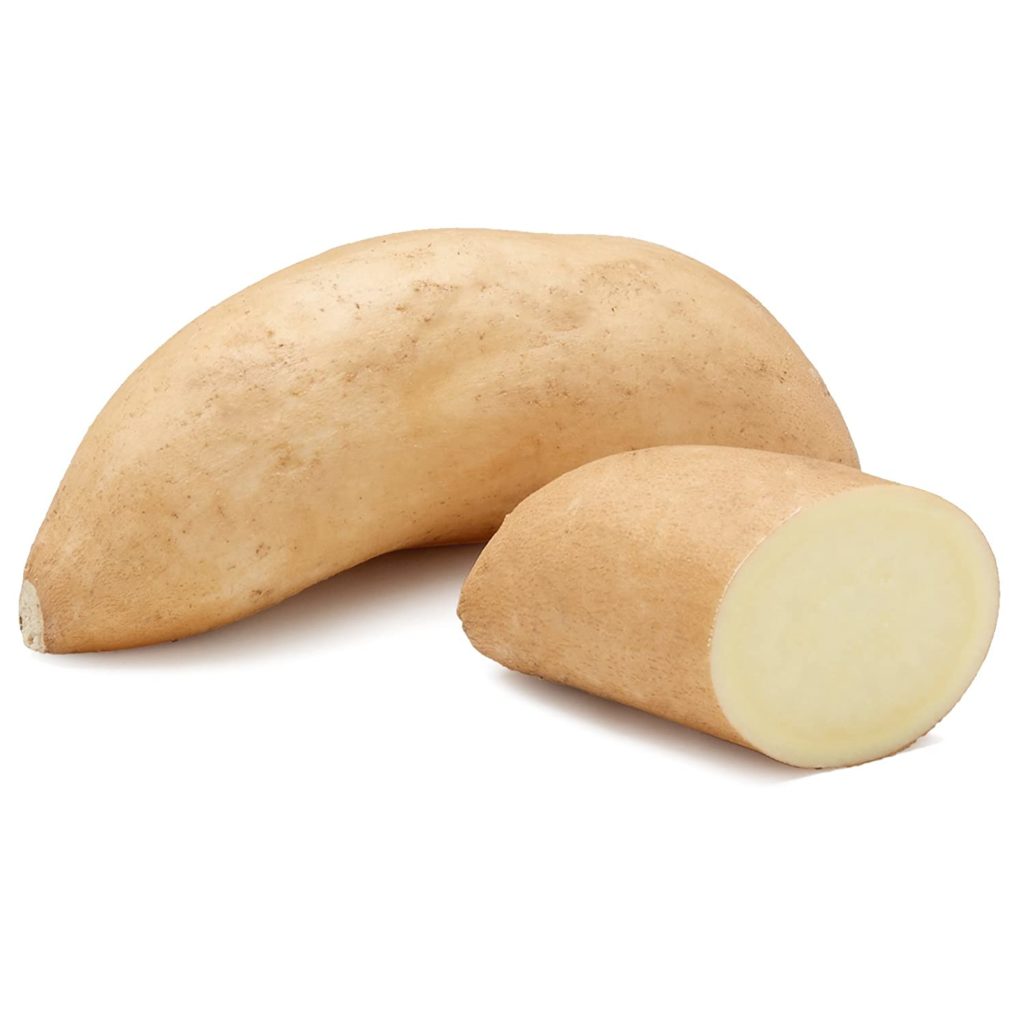
There are also other white types, but this being the most common.
Has a sweet taste and creamy color. A bit on the drier and firmer side than most types. This is a good type for sweet potato fries and wedges.
Sweet Potato Finger Food – BLW Style
You might ask what is “baby led weaning”? – BLW is a feeding style that allows for the baby to feed themselves right from the start. This allows the baby to develop faster. Use food that is in good grabbable chunks and is squishable so there is no risk of choking. Also this method is less work for you and allows the baby to become more self-dependent.
Sweet potato wedges are one of the best options for baby led weaning as they are soft and easy to grab. Use finger-sized wedges. When making BLW wedges you might opt for the more mushier orange sweet potato type for a more softer result.For a more in depth guide check out this article.
How to Cook for Babies
Sweet potatoes are easy to make in every form and it is a great first food for babies. For its health benefits and as it’s easy to produce it is most moms first choice. Sweet potatoes are not only for babies – you can make homemade puree/jam or mash for your other dishes as well adding extra flavor and nutrients to your morning porridge, pastries and sauces.
Purees
Sweet potato puree is easy to make at home. There are several ways to cook puree but only one ingredient is required – sweet potato!
Different ways of cooking sweet potatoes for purees:
- Roasting – This is the easiest way to bake sweet potato and gives the most flavour to purees. Prick small holes with a fork into sweet potato, preheat the oven to 200C/400F and put on the baking tray, covered with baking paper. Cook for about 45 minutes or until the potato is tender and the skin is wrinkled. Let it cool before peeling.
- Boling – Bring water to boil, peel the sweet potato and cut small cubes. Add potato to water and let it boil for about 15 minutes until it’s tender.
- Steaming – The healthiest way to make sweet potato puree, that’s how you can maintain the majority of nutrients. You can use a steamer or make one of your own (just add metal sieve on top of the boiling water pot and cover with a lid). Peel and cut your sweet potato to small cubes, place the cubes in the steamer and steam until ready.
For pureeing the sweet potato you can use a food processor (easiest way), blender or a masher. If puree becomes too thick you can add a splash of water, breast milk or milk for babies. There are different ways to make your puree fun and versatile by adding or mixing other pureed foods like apples, carrots, bananas etc. In general don’t add salt for babies under the age of 1.
Wedges
For 1+ year old toddlers you can make sweet potato wedges with oil and salt. For some additional flavour you can add cinnamon or crushed rosemary. The best method to ensure even cooking is to make even wedges and place them evenly on the baking sheet. Preheat the oven to 200C/400F and cook for 25 to 30 minutes.
Best Storage Life
The easiest way to store your puree is to freeze it. Place puree into ice cube trays and put it in the freezer. You can take it out anytime when you need it and use the amount you need. A flexible ice cube tray is good to get the puree out quickest. Never refreeze previously frozen puree.
If storing in the fridge keep puree or wedges in an airtight container up to 5 days.
Recipes and Combinations
Following is our top pick for easy recipes.
Simple puree recipes:
Puree recipes that combine additional healthy ingredients:
- Sweet Potato Banana Cinnamon Baby Puree Mix
- Sweet Potato Beet Beans Puree Combo
- Sweet Potato Carrot Cauliflower Chia Seed Puree
Recipes for wedges:
Ready-To-Go Baby Food & Purees
There are always days when you have more things to do than you have time and puree making is out of the question. These are the days when ready-made pre-packed baby food products can come to help. Baby food pouches are easy to take on the go or just grab when you need it.
Another good benefit of these is that they don’t go stale when carrying around. There is a variety of organic options with different flavours and shapes. As long as you don’t use these too often then it’s good to have a backup of ready-made puree for hectic times. Prefer homemade puree as it’s more environmentally friendly and cheaper. Most ready purees are meant for 6+ month old babies but there is something for each stage.
If you are looking for a vegan option, then make sure to double-check the ingredients as some of these types of products tend to contain meats.
1. Happy Baby – Organic Sweet Potatoes, Mangos & Carrots
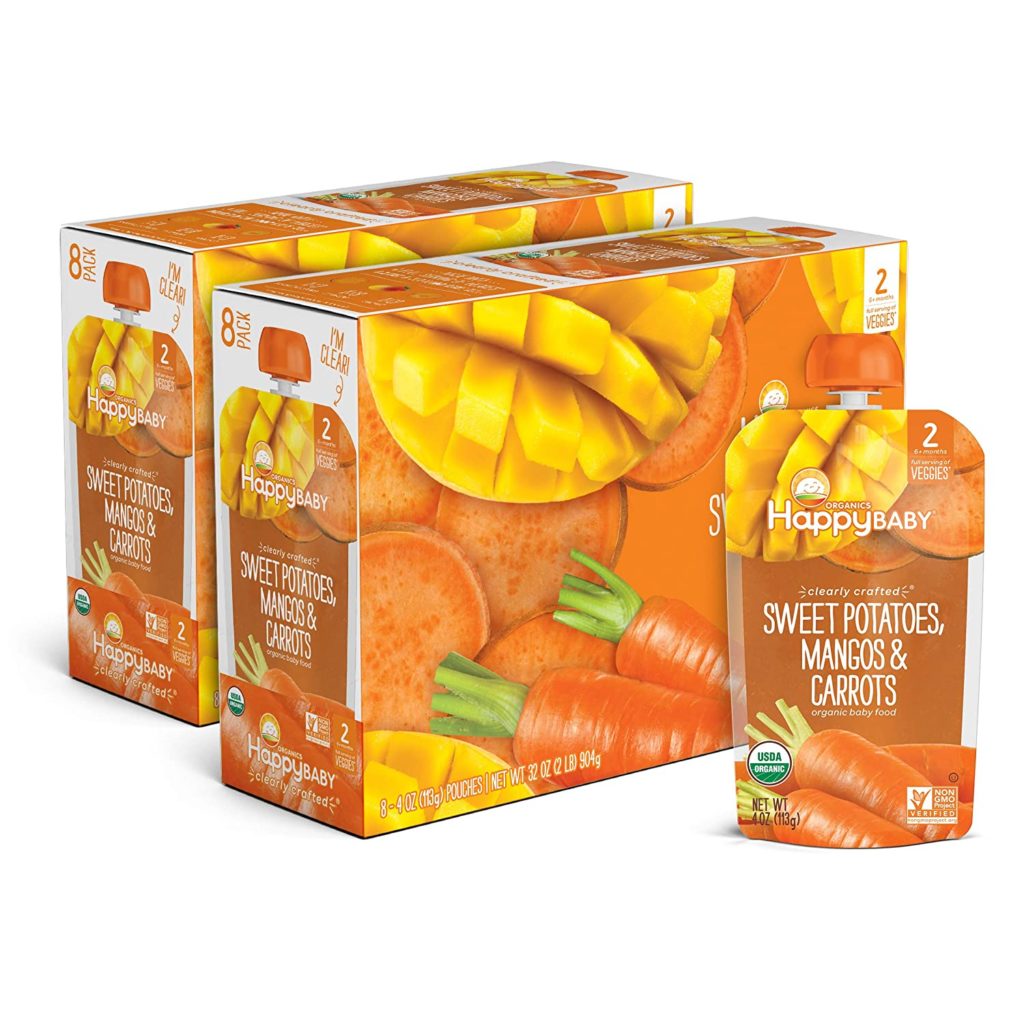
Happy Baby – Clearly Crafted
The Happy Family pouches include a variety of organic fruits, vegetables, grains and even seeds. Purees are high in important nutrients and contain a variety of vitamins. They have the most interesting food combos like sweet potato, banana and papaya or apples, sweet potato, carrots & cinnamon plus chia seeds, yumm! Perfect for picky eaters and so easy to grab on the go.
2. Gerber – Pureed Baby Food
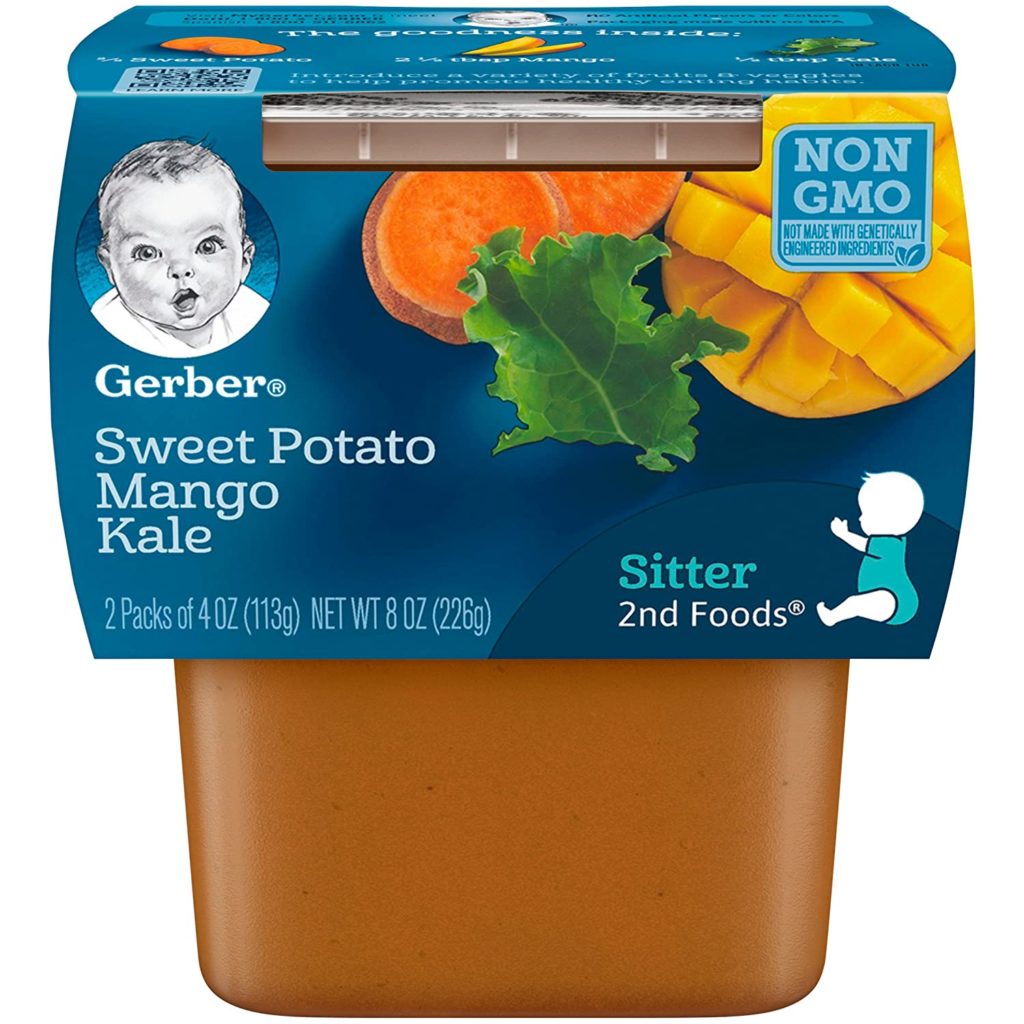
Gerber purees are perfect when the baby is ready to try different puree combos. Purees are unsweetened and unsalted, with no added artificial colors, flavors or starch. Gerber meals are shelf stable so it’s easy to maintain. Great price!
3. Plum – Sweet Potato, Apple and Corn
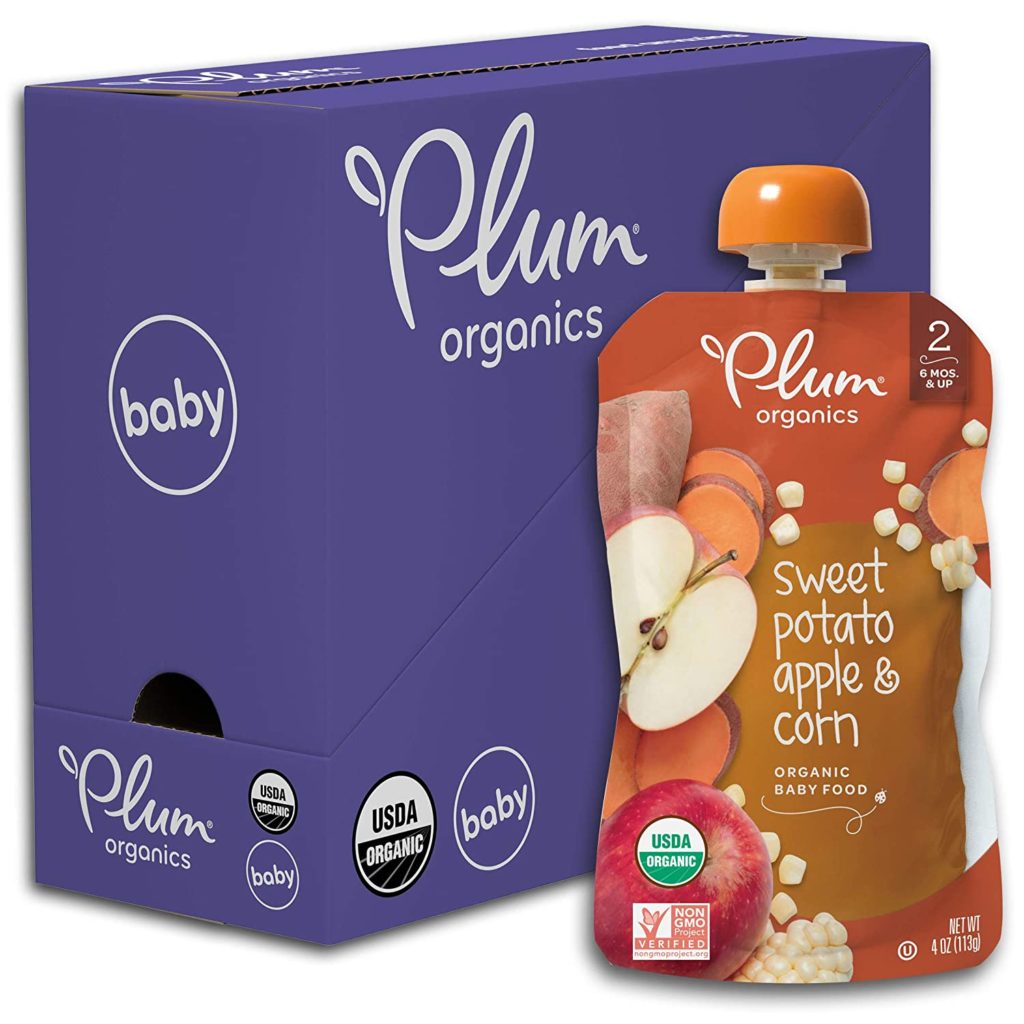
Plum uses non-GMO organic ingredients, no sweeteners or salt. They make something for every stage of the baby, from early eaters to toddlers. Plum has a very small environmental footprint and their non-BPA pouches have recycable caps. They are very committed to our planet so it is the perfect choice when you are organic like them! Of Course they have huge variations of different puree combos and high value of nutritions.
4. Mama Bear – Sweet Potato & Apple
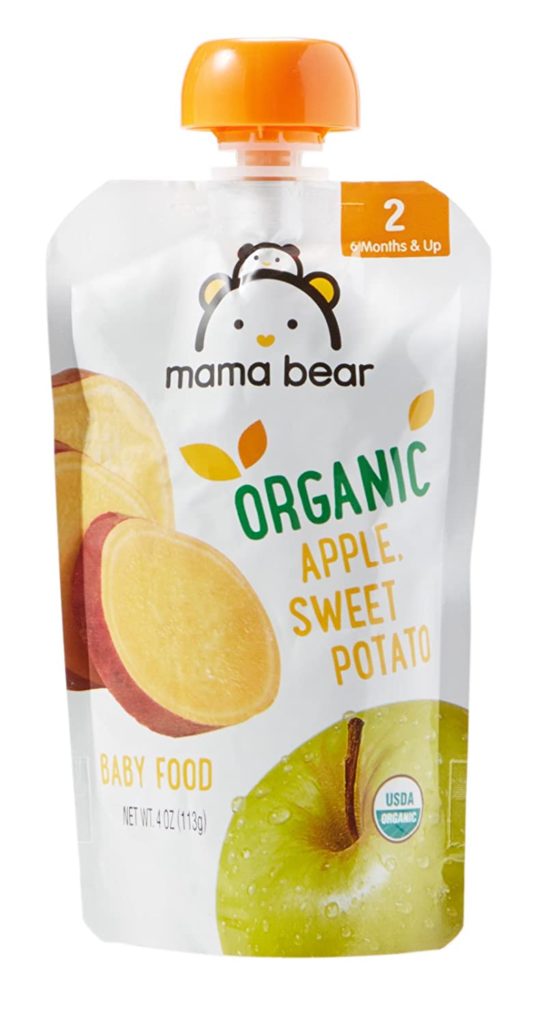
Pouches are very convenient and easy to use. Mama bear doesn’t use artificial colors or flavors and they are gluten free and use non-GMO ingredients. They have stage 1 for 4-month old babies and stage 2 for babies over 6 months.
5. Earth’s Best – Apple, Sweet Potato, Pumpkin and Blueberry
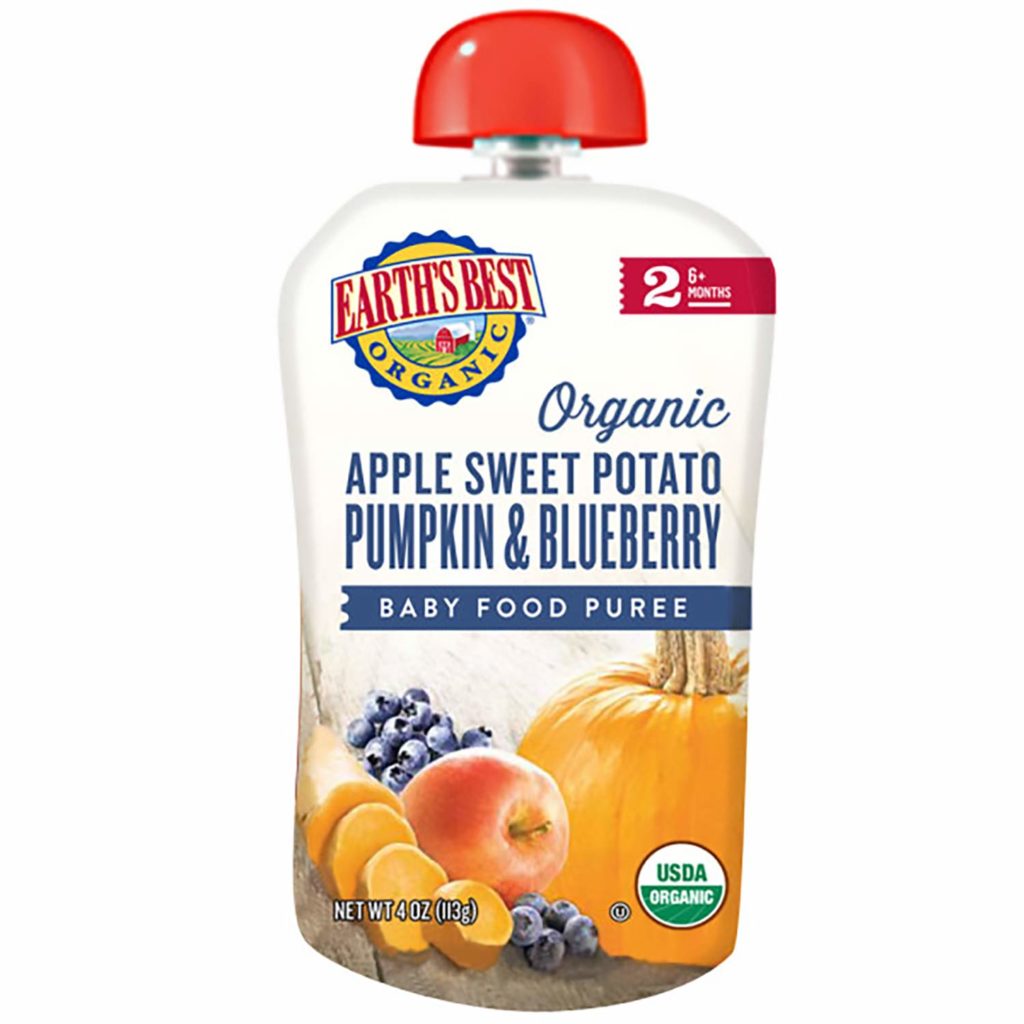
Packaged in BPA-free pouches and purees are made from non-GMO ingredients. They have multiple stages of purees for different ages (stage 2 for over 6-month old babies and stage 3 for 9-month old babies). They use simple ingredients found in nature. Great option!
6. Happy Baby – Organic Superfood – Puffs
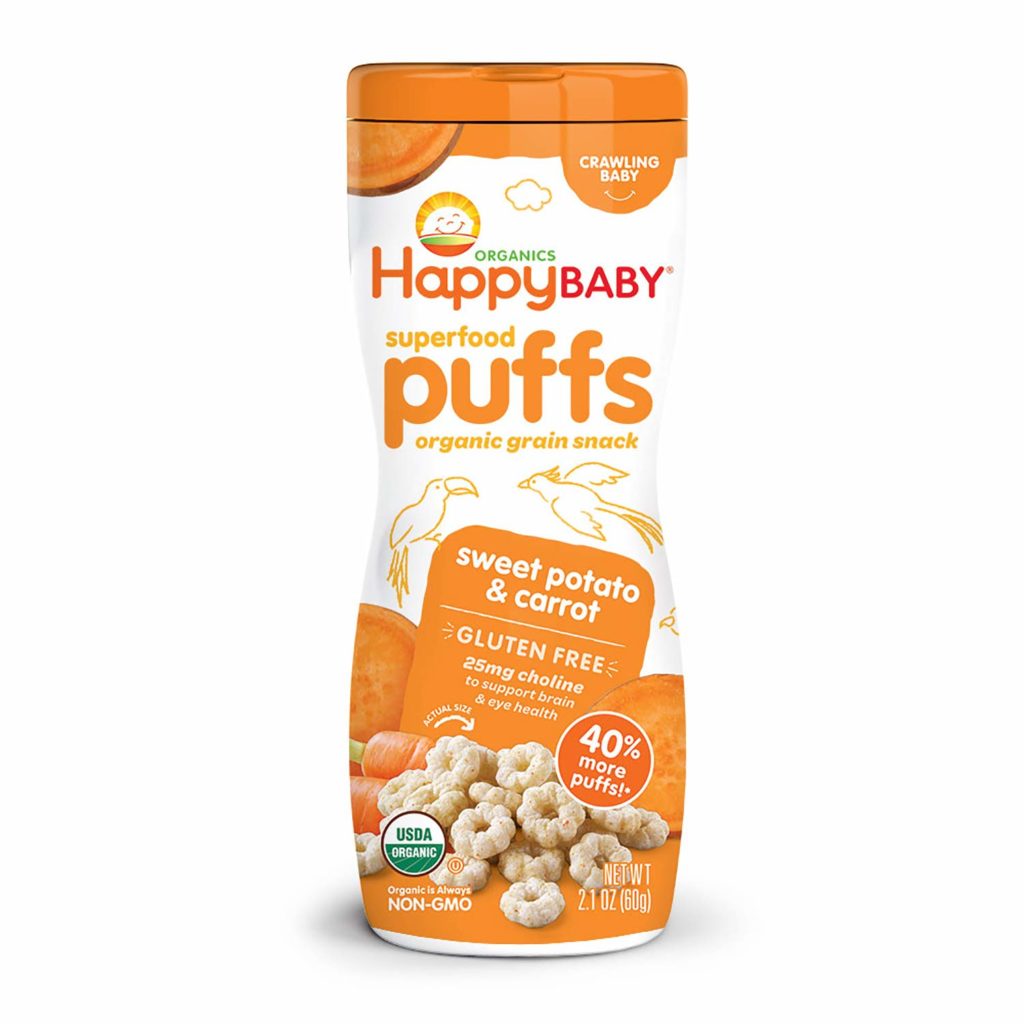
Happy baby puffs are more developed for encouraging self eating. Puffs are lightly sweetened with real fruit juice and contain vitamins and minerals. They come in different flavours, are organic and made from non-GMO ingredients. You can win some free time with these puffs!
Let us know if we missed something down in the comments below 🙂

